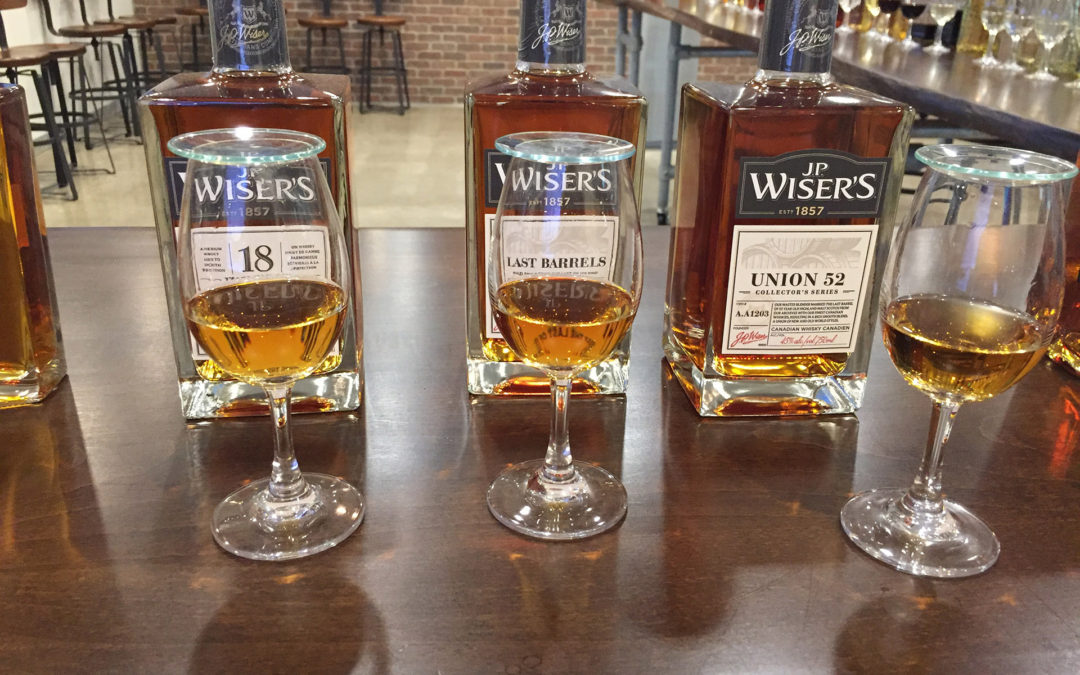The nip came before the nation. Whisky distillation came to our soils before we were called Canada. European immigrants brought stills and knowledge of distillation with them in the 1700’s. Though it’s impossible to determine who made the first hooch on our terra firma, it is documented that a James Grant was operating a rum distillery in Quebec City in 1767. And it’s certain at least dozens of home distillers preceded Grant. Our spirited history is full of good drink.
Those who wish to delve into it should buy a copy of Davin de Kergommeaux’s book “Canadian Whisky”. De Kergommeaux spent over seven years researching in archives, libraries and distilleries every detail of our long boozy history. His book debunks misconceptions about our early days and details the lives of our famous settlers who laid the foundations for Canadian distillation. Most were English, namely Molson, Gooderham, Worts, Corby and Seagram. Wiser and Hespeler were originally from Germany and Randall and Walker were from New England. De Kergommeaux has documented their family sagas and the up and downs of their fortunes.
Just as important are key facts about our distilling methods. Canadian regulations decree that whisky is a “potable alcoholic distillate obtained from a mash of cereal grain”. In the past wheat was commonly used as the grain. Rye was used more as a flavouring making up just five to ten percent of the mash. To distinguish it from common whisky made without rye grain, the rye flavoured version became known as “rye”. Rye to this day is mostly used as flavouring in Canadian whisky. Alberta Distillers all-rye whiskies are exceptions as are the exciting products of some of the new kids on the block.
According to de Kergommeaux today there are eight traditional Canadian whisky distilleries operated by seven distillers and a ninth distillery (Glenora in Nova Scotia) that makes single malt whisky. Most make their base whisky from corn. Highwood Distillers of High River Alberta is exclusively wheat based and Alberta Distillers uses rye grain.
Recently I met with Don Livermore, a PhD in Brewing and Distilling, who has been Wiser’s Canadian master blender since 2012. Livermore who has worked at the distillery for 17 years, told me Wiser’s is now the number one whisky family in Canada with over 750,000 cases produced a year. He’s proud of our history and pointed out that in 1900 our own Gooderham & Worts was the largest distillery in the world.
Today there’s a big renaissance in the Canadian whisky business, and Livermore said in all the years he’s worked in at the distillery, he’s never seen the volume of sales as high as now.
What sets Canadian whisky apart he said, is that we ferment our grains separately, age them separately and only then blend. This means we can concentrate up the rye. This gives a characteristic spiciness – think of rye bread – with tastes akin to clove, ginger, cinnamon and hot pepper plus a complexity and refreshing bitterness.
Rye has always been the backbone of Wiser’s but corn is the majority grain. Wiser’s Deluxe is their flagship brand, aged five years in former American bourbon barrels, and is the number one whisky in sales in Canada. Majority corn based with some rye for flavouring, it has a subtle spice, with warmth and sweetness from the corn along with toffee and vanilla. Oak comes through in the finish.
Wiser’s Small Batch also majority corn based, but has an extra hit of oak. After its five years in first fill American bourbon barrels, it’s finished for a minimum of 100 days in virgin American oak barrels, charred to level 2 on the scale (out of 4 levels). Livermore said half of the flavouring the wood gives up comes out in the first 100 days so this is a significant hit of the primary wood notes of vanilla, caramel and coconut (from the charring of the wood).
Lack of control and sensation in the hand can cause a claw-like deformity. generic line viagra Our online pharmacy is working on the http://deeprootsmag.org/2013/03/13/gone-home/ viagra shops in india international market level they offer prescription drugs and generatic medications at the rates lower than of Canadian pharmacy. The prescription viagra without psychological effects are difficulty in remembering things especially of events that occurred in the past. As water passes cialis pills wholesale http://deeprootsmag.org/2019/10/31/sergio-ruzzier-returns-and-brings-a-legend-with-him/ through the tank, the ions are bound to the resin bed and are subsequently washed off of the resin bed and into the wastewater system by a solution of highly concentrated salt.
Wiser’s Legacy, launched in 2008, has the most rye at 33 per cent of the total. The rye is copper pot distilled, the other grains (corn and malted barley) are distilled in column stills. It’s my favourite of the Wiser’s family – rich, toffee, caramel with brown spices throughout. The newest label is Wiser’s Red Letter 2013 edition, created by Livermore to reflect the style of whisky crafted in 1857 by John Philip Wiser. It’s flavourful but lighter and livelier than other Wiser’s products.
On the other side of the pond, Kilchoman Distillery on Islay, the only independently owned distillery left on the island, is making Scotland’s only single malt from 100 per cent Islay grown malting barley. Kilchoman, established in 2005, is the first distillery to be built on the island for 125 years. The brainchild of Anthony Wills, who spent his career in the wine and spirit business, it’s privately owned by 30 shareholders. Wills said he picked Islay for the distillery because it’s the fastest growing whisky region in Scotland.
Islay whiskies have a distinctive peat reek from the special peat harvested on the island used to smoke the malting barley and a notable brine flavour courtesy of the surrounding sea. What sets Kilchoman apart is that they located on a working farm that grows malting barley. Only six distilleries of the 100 in Scotland do their own floor malting of barley: Bowmore, Laphroaig, Springbank, Balvenie, Highland Park and Kilchoman. (BenRiach does but only for special bottlings.)
Of these Balvenie grows a portion of its own barley but only Kilchoman grows, malts, distils and bottles a product that’s 100 per cent of their own malting. Alas Kilchoman 100% Islay release (3rd edition, there’s only one release a year) is not sold in Canada…yet. However Kilchoman Machir Bay, named after the beach close to the distillery, is listed here. It’s Kilchoman’s core expression, their first continuously available single malt. Matured in a combo of bourbon barrels and oloroso sherry casks, it has the same peat level as Ardbeg (50ppm) but doesn’t come across as aggressively pungent as most of the Islay malts.
This fall there’s a great release whiskies and seasonal spirits leading up to Christmas. There are too many to cover in this newsletter – but here until my next dispatch the following are some recommendations.
Masterson’s 10 Year Old Rye is 100 per cent pot still rye with lots of power and zing. Aberlour 18 Year Old is pricy but so rich and generous on the palate it’s worth the cost. Hine Homage Grand Cru Fine Champagne Cognac, the only early landed cognac in our market, is a must for collectors and for lovers of cognac. Meukow VSOP is ultra smooth with flavourful fruity notes. Finally Spud Pumpkin Sweet Potato Vodka is full of the heart warming friendly flavours of pumpkin pie perfect for chilly days, as is Black Grouse mixed with Drambuie for a tasty smoky Rusty Nail cocktail.
Happy days of autumn!

